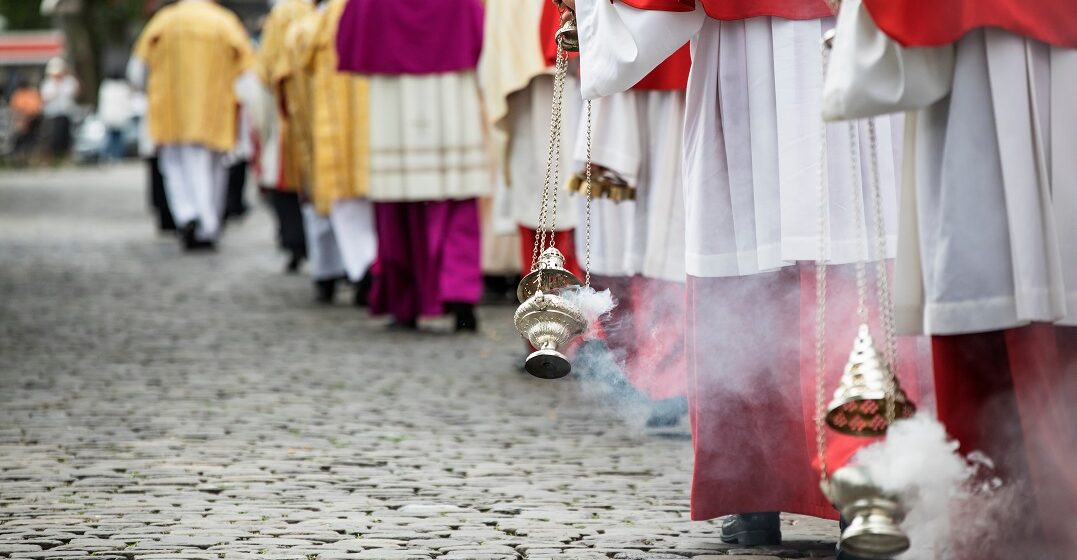Published on May 12, 2023

Origin and celebration of Corpus Christi in Germany

Fronleichnam is the German word for Corpus Christi. For Catholics, it is a day to remember and celebrate the presence of the flesh and blood of Jesus Christ in the Holy Communion. Fronleichnam always falls on the Thursday that comes 60 days after Easter Sunday, and it is observed in some (predominantly Catholic) parts of Germany as a public holiday.
So, how do Catholic Germans celebrate Corpus Christi? Processions of the Eucharist through the streets of the community are a big part of the traditional celebrations. In some regions, colorful and distinctive customs have evolved that are worth checking out if you have an interest in religious history. Of course, if you’re just wondering about Fronleichnam because you have the day off, it still helps to know what you should expect to see around you.
As mentioned above, Fronleichnam is a literal translation from the Latin corpus christi, meaning “body of Christ.” The name goes back to the old German vron and licham which translate to “body of the Lord.”
This ancient linguistic heritage points to the medieval origins of this Christian holiday. The origins stretch all the way back to the 13th century, when the canoness Juliana of Liège witnessed a vision of Christ telling her to initiate a day of remembrance for the Holy Eucharist. The Holy Eucharist refers to an important Christian rite and sacrament instituted during the Last Supper, when Jesus shared bread and wine with his disciples, telling them that these were his flesh and his blood.
In 1246, Juliana convinced the bishop of the local dioceses to order an annually held Corpus Christi celebration. In 1264, Pope Urban IV instituted the feast for the entire Latin Church in his papal bull Transiturus. He set the day for the celebration of Corpus Christi as the Thursday after Trinity Sunday — the second Thursday after Whitsunday, falling ten days after Pentecost and 60 days after Easter Sunday.
Corpus Christi is mainly a Roman Catholic feast, though it is also observed in several other Christian communities, such as the Church of England.
In Germany, religion became a contentious topic when Martin Luther kicked off the Protestant Reformation. Luther and his ilk turned against the Corpus Christi holiday. He took offense at the Eucharist being paraded through town.
This explains why Corpus Christi is not a public holiday throughout Germany, but is instead observed only in some predominantly Catholic states. These states include Baden-Württemberg, Bavaria, Hesse, North Rhine-Westphalia, Rhineland-Palatinate and Saarland, as well as some parts of Saxony and Thuringia. Falling on a Thursday, the day offers an opportunity for a long weekend. A lot of people will take off Friday and go on a short trip.
How Corpus Christi is celebrated in Germany depends a lot on where you are. Church service is always a part of the celebrations, but regional customs may vary greatly.
Most commonly, there is a procession of the Eucharist in its monstrance through brightly decorated streets. Sometimes children wear white, while adults opt for more traditional clothing. In regions such as the Black Forest, this clothing may take the form of colorful flower carpets.
Other traditions abound. In Bamberg, a massive 650-kilogram cross is carried by 18 men through the city. And in Cologne, more than 100 ships parade on the Rhine, which has nothing to do at all with the Last Supper. Legend has it that a thief had been stopped from crossing the river through some form of divine intervention, which somehow became the origin of this very special tradition.
On Fronleichnam, Catholics remember the Last Supper and its celebration in the Holy Communion. This is a deeply important holiday for practicing Catholics and some other Christians, though it’s only a holiday in the predominantly Catholic parts of Germany. Celebrations usually involve church services and processions, but regional customs can be very different.